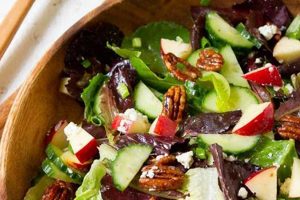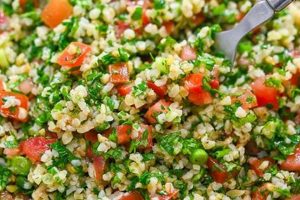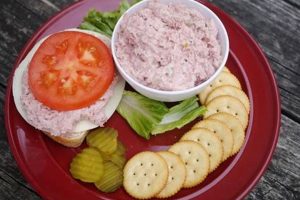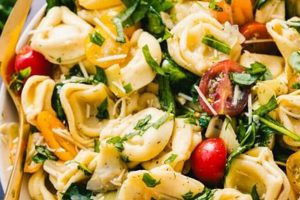Dried cranberries, often marketed under the brand name Craisins, are a popular addition to a variety of salads. These recipes typically incorporate the tart-sweet berries into a mix of fresh produce, nuts, seeds, and often a complementary dressing. Examples include combinations with leafy greens, broccoli, carrots, sunflower seeds, and vinaigrette dressings, or with cabbage, apples, and a creamy mayonnaise-based dressing.
The inclusion of dried cranberries contributes both flavor and nutritional value. They provide a burst of sweetness that balances other ingredients, while also offering a chewy texture that contrasts with crisp vegetables. Furthermore, dried cranberries are a source of antioxidants and dietary fiber. Their use in salads reflects a broader culinary trend towards incorporating dried fruits into savory dishes, adding complexity and depth of flavor.
This exploration will delve further into specific formulations, examining variations in ingredients, dressings, and preparation techniques. Nutritional information and potential health benefits will also be addressed.
Tips for Crafting Delicious Dried Cranberry Salads
Elevating a simple salad with dried cranberries involves careful consideration of ingredient pairings and preparation methods. The following tips offer guidance for creating flavorful and visually appealing dishes.
Tip 1: Balance Sweetness and Acidity: The inherent sweetness of dried cranberries benefits from balancing flavors. Tart dressings, such as those made with citrus juice or vinegar, provide a counterpoint. Consider incorporating acidic fruits like green apples or grapefruit segments.
Tip 2: Explore Textural Variety: Dried cranberries offer a pleasant chewiness. Enhance this textural dimension by including crunchy elements like toasted nuts (almonds, pecans, walnuts), seeds (sunflower, pumpkin), or croutons.
Tip 3: Consider the Dressing: Creamy dressings, like those based on mayonnaise or yogurt, complement the sweetness of dried cranberries, while vinaigrettes offer a lighter, tangier option. Experiment to find preferred flavor profiles.
Tip 4: Don’t Overdo It: While flavorful, dried cranberries are best used in moderation. Their concentrated sweetness can overpower a salad if used excessively. Start with a smaller quantity and adjust to taste.
Tip 5: Rehydrate for Plumper Berries: Soaking dried cranberries in warm water or juice for 15-20 minutes before adding them to the salad can plump them up, resulting in a softer texture.
Tip 6: Pair with Cheeses: Consider adding crumbled cheeses like feta, goat cheese, or blue cheese for a salty, tangy counterpoint to the sweetness of the cranberries and a further textural element.
Tip 7: Experiment with Greens: While spinach and romaine are popular choices, explore other greens like kale, arugula, or mixed greens for varied flavor profiles and nutritional benefits.
By following these tips, one can create salads that showcase the versatile nature of dried cranberries, resulting in dishes that are both flavorful and visually appealing. Careful attention to ingredient combinations and preparation techniques ensures a balanced and satisfying culinary experience.
The following section will explore specific recipe examples, providing practical applications of these tips and showcasing the versatility of dried cranberries in salad preparation.
1. Flavor Balance
Flavor balance is paramount in dried cranberry salads due to the berries’ inherent sweetness. Without careful consideration of other ingredients, this sweetness can become overwhelming, resulting in a one-dimensional sensory experience. A successful recipe tempers the sweetness with contrasting flavors, creating a more complex and enjoyable dish. This balance can be achieved through several methods.
Acidity is a key component in balancing sweetness. Ingredients such as citrus fruits (oranges, grapefruits), vinegars (apple cider, balsamic), and tart apples (Granny Smith) provide the necessary counterpoint. For example, a salad featuring dried cranberries, crumbled feta cheese, and orange segments benefits from the interplay of sweet, salty, and acidic notes. Similarly, a vinaigrette dressing with lemon juice or vinegar can effectively cut through the sweetness of the cranberries. The selection of greens also plays a role; peppery arugula or tangy spinach can contribute to the overall balance.
Savory elements further enhance flavor complexity. Nuts, such as pecans or walnuts, offer a rich, earthy counterpoint to the sweetness of the cranberries. Seeds, like pumpkin or sunflower seeds, provide a subtle nuttiness and pleasing texture. Additionally, the inclusion of cheeses, such as sharp cheddar or creamy goat cheese, introduces salty and tangy notes that complement the cranberries. Even savory herbs, like thyme or rosemary, can add depth and complexity to the flavor profile.
Achieving flavor balance in a dried cranberry salad is essential for creating a truly satisfying dish. The interplay of sweet, acidic, salty, and savory elements elevates the recipe beyond simple sweetness, resulting in a more nuanced and enjoyable culinary experience. Understanding these principles allows for creative exploration and customization, leading to salads that are both delicious and well-balanced.
2. Texture Variety
Textural variety is a crucial element in crafting appealing and satisfying dried cranberry salads. The inherent chewiness of dried cranberries provides a foundation, but a truly successful recipe incorporates a range of textures to create a more dynamic and enjoyable eating experience. This diversity prevents monotony and adds complexity to each bite.
- Crunchy Elements
Crunchy components provide a stark contrast to the chewy cranberries and softer elements often found in salads. Nuts, such as toasted almonds, pecans, or walnuts, offer a satisfying crunch and complementary flavors. Seeds, including sunflower, pumpkin, or sesame seeds, contribute a delicate crispness. Croutons, whether store-bought or homemade, introduce a substantial crunch and can be flavored to complement the overall salad profile. These elements create textural interplay, enhancing the sensory experience.
- Soft Elements
Leafy greens, such as spinach, romaine, or butter lettuce, offer a soft, delicate counterpoint to the chewiness of dried cranberries and the crunch of nuts or seeds. Other soft ingredients, like avocado or cooked quinoa, can further enhance this textural dimension. The interplay of soft and chewy elements creates a balanced and satisfying mouthfeel.
- Chewy Elements
While dried cranberries provide a foundational chewiness, other ingredients can amplify this texture. Consider adding dried apricots, dates, or other dried fruits. These not only contribute additional chewiness but also introduce complementary flavors that enhance the overall complexity of the salad.
- Firm Elements
Adding firm components, such as diced apples, pears, or cucumbers, provides another layer of textural contrast. These ingredients offer a crisp-tender bite that complements both the chewy cranberries and the softer greens. Their inclusion creates a more dynamic and satisfying salad experience.
By thoughtfully combining ingredients representing these various textural categories, one can create dried cranberry salads that are not only flavorful but also offer a stimulating and enjoyable textural experience. The interplay of crunchy, soft, chewy, and firm elements elevates the salad from a simple mix of ingredients to a more complex and satisfying dish. Attention to texture, alongside flavor balance, is a key factor in creating a truly successful and memorable salad.
3. Ingredient Combinations
Ingredient combinations are fundamental to successful dried cranberry salad recipes. The inherent sweetness and chewiness of dried cranberries necessitate careful selection of complementary components to create a balanced and flavorful dish. Strategic combinations elevate the salad beyond a simple sum of its parts, resulting in a complex interplay of flavors, textures, and aromas. Understanding the principles behind these combinations empowers culinary creativity and ensures a satisfying gastronomic experience.
Several factors influence optimal ingredient selection. Balancing sweetness is paramount. Tart fruits, such as green apples or mandarin oranges, provide acidity that counteracts the sweetness of the cranberries. Tangy cheeses, like feta or goat cheese, offer a similar balancing effect while adding a salty, creamy dimension. Savory components, such as roasted nuts, toasted seeds, or crumbled bacon, introduce contrasting flavors and textures that enhance the overall complexity. Leafy greens, chosen for their flavor profiles and textures, provide a foundation for the salad, with options ranging from mild spinach to peppery arugula. Consideration must also be given to the intended dressing, ensuring compatibility with the chosen ingredients.
Specific examples illustrate the importance of thoughtful ingredient combinations. A salad featuring dried cranberries, crumbled blue cheese, candied pecans, and baby spinach, tossed in a balsamic vinaigrette, demonstrates a successful interplay of sweet, salty, tangy, and savory elements. The creamy texture of the cheese contrasts with the crunch of the pecans and the delicate spinach, while the vinaigrette provides a unifying acidic touch. Conversely, a combination of dried cranberries, shredded carrots, sunflower seeds, and a creamy ranch dressing might lack the necessary balance, with the sweetness of the cranberries and carrots potentially overwhelming the other flavors. Therefore, understanding the interplay of ingredients is essential for creating harmonious and flavorful dried cranberry salads.
In conclusion, ingredient combinations are not arbitrary choices but rather deliberate decisions that significantly impact the overall success of a dried cranberry salad recipe. Careful consideration of flavor profiles, textures, and the interplay between ingredients is crucial for achieving a balanced and satisfying culinary outcome. A deep understanding of these principles allows for creative exploration and customization, enabling the creation of salads that are both delicious and nutritionally sound.
4. Dressing Choices
Dressing selection significantly impacts the overall flavor profile and balance of dried cranberry salads. The inherent sweetness of dried cranberries necessitates careful consideration of dressing characteristics to avoid an overly sweet or unbalanced dish. Appropriate dressing choices enhance the interplay of flavors and textures, contributing to a more satisfying culinary experience. Understanding the nuances of various dressing types and their interaction with other salad components is crucial for crafting a successful recipe.
- Vinaigrettes
Vinaigrettes, typically composed of oil and vinegar, offer a bright, acidic counterpoint to the sweetness of dried cranberries. The acidity cuts through the richness of the fruit, creating a balanced flavor profile. Variations in vinegar type, such as balsamic, apple cider, or red wine vinegar, introduce nuanced flavor complexities. Adding herbs, spices, or Dijon mustard further enhances the vinaigrette, creating a customized dressing that complements the other salad ingredients.
- Creamy Dressings
Creamy dressings, often based on mayonnaise, yogurt, or sour cream, provide a richer, more decadent complement to dried cranberry salads. These dressings can enhance the sweetness of the cranberries, creating a harmonious blend of flavors. However, careful consideration must be given to the overall balance of the salad, as an overly rich dressing can overwhelm lighter ingredients. Incorporating herbs, spices, or citrus zest into creamy dressings can add complexity and prevent them from becoming too heavy.
- Nut-Based Dressings
Nut-based dressings, such as those made with tahini or cashew cream, offer a unique flavor profile and creamy texture. Their earthy notes can complement the sweetness of dried cranberries, creating a more nuanced flavor experience. These dressings also contribute healthy fats and other nutrients. Adjusting the consistency with water or citrus juice allows for customization to suit the specific salad composition.
- Citrus-Based Dressings
Citrus-based dressings, featuring fresh citrus juice as a primary component, provide a vibrant, tangy counterpoint to the sweetness of dried cranberries. These dressings are often light and refreshing, making them ideal for salads featuring fresh greens and lighter ingredients. The acidity of the citrus juice balances the sweetness of the cranberries, creating a harmonious flavor profile. The addition of herbs, spices, or a touch of honey can further enhance the complexity of the dressing.
The choice of dressing is integral to the overall success of a dried cranberry salad. By carefully considering the flavor profile of the chosen dressing and its interaction with other ingredients, one can create a balanced and harmonious dish. Whether opting for a light vinaigrette, a rich creamy dressing, a nutty option, or a zesty citrus blend, the selected dressing should enhance the flavors of the other components while contributing its own unique characteristics. Ultimately, the best dressing choice depends on the specific ingredients and desired flavor profile of the salad.
5. Nutritional Value
Nutritional value represents a significant component of dried cranberry salad recipes. Beyond flavor and textural considerations, these salads offer opportunities to incorporate nutrient-rich ingredients, contributing to a balanced and healthful diet. Dried cranberries themselves offer several nutritional benefits. They are a source of antioxidants, particularly proanthocyanidins, which are associated with urinary tract health. They also provide dietary fiber, contributing to digestive health and satiety. However, it’s crucial to acknowledge that dried cranberries often contain added sugar, impacting overall caloric content. Therefore, portion control and awareness of specific product nutritional information are essential.
The nutritional value of a dried cranberry salad extends beyond the cranberries themselves. Incorporating a variety of fresh produce, such as leafy greens, vegetables, and fruits, significantly increases the vitamin, mineral, and fiber content. Leafy greens contribute vitamins A, C, and K, while vegetables like carrots and broccoli provide additional vitamins and minerals. Adding nuts and seeds further enhances the nutritional profile, providing healthy fats, protein, and fiber. For example, a salad with spinach, carrots, walnuts, and dried cranberries offers a broader spectrum of nutrients than one solely focused on lettuce and cranberries.
Maximizing nutritional value requires careful consideration of ingredient choices and preparation methods. Opting for nutrient-dense vegetables, such as dark leafy greens and colorful vegetables, over less nutritious options, like iceberg lettuce, increases the overall nutritional benefit. Minimizing added sugars and unhealthy fats in dressings is also crucial. Homemade vinaigrettes with olive oil and vinegar offer a healthier alternative to store-bought dressings, which often contain high levels of sodium and added sugars. Furthermore, portion sizes play a critical role in managing overall calorie intake. Even nutrient-rich salads can contribute to weight gain if consumed in excessive quantities. Understanding these principles allows individuals to create dried cranberry salads that are not only delicious but also contribute to a balanced and health-conscious diet.
Frequently Asked Questions
This section addresses common inquiries regarding dried cranberry salad recipes, providing concise and informative responses.
Question 1: How can one mitigate the concentrated sweetness of dried cranberries in salads?
Balancing the sweetness of dried cranberries requires incorporating acidic or savory elements. Tart fruits like green apples or citrus segments, tangy cheeses such as feta or goat cheese, and acidic dressings like vinaigrettes effectively counteract the sweetness.
Question 2: What are optimal ingredient pairings for dried cranberries in salads?
Complementary ingredients include leafy greens (spinach, arugula), nuts (pecans, walnuts), seeds (sunflower, pumpkin), cheeses (feta, blue cheese), and fruits (apples, oranges). These ingredients offer contrasting flavors and textures, enhancing the overall salad experience.
Question 3: What dressings work best with dried cranberry salads?
Both vinaigrettes and creamy dressings can complement dried cranberry salads. Vinaigrettes offer a light, acidic counterpoint to the sweetness, while creamy dressings, if not overly rich, can enhance the sweetness and create a more decadent flavor profile.
Question 4: Can dried cranberries be rehydrated before adding them to a salad?
Rehydrating dried cranberries by soaking them in warm water or juice for 15-20 minutes prior to use can plump them, resulting in a softer, more succulent texture.
Question 5: Are there specific nutritional benefits associated with dried cranberries in salads?
Dried cranberries offer antioxidants and dietary fiber. However, they often contain added sugar, so moderation is key. The overall nutritional value of the salad depends on the incorporated ingredients, such as nutrient-rich vegetables, fruits, nuts, and seeds.
Question 6: How can one prevent dried cranberry salads from becoming overly sweet?
Balance is key. Incorporate acidic elements like citrus fruits or vinaigrettes, savory components like nuts or cheeses, and avoid overly sweet dressings. Taste-testing and adjusting ingredients as needed ensures a balanced flavor profile.
Careful consideration of these frequently asked questions empowers individuals to create flavorful, balanced, and nutritionally sound dried cranberry salads tailored to individual preferences.
Further exploration of specific recipes and variations will follow in the next section.
Craisin Salad Recipes
Dried cranberry salad recipes offer a versatile platform for culinary creativity. Successful formulations prioritize a balance of sweet, acidic, and savory flavors, incorporating textural variety through a combination of ingredients. Careful dressing selection further enhances the overall flavor profile, while mindful ingredient choices contribute to nutritional value. From the tangy burst of a vinaigrette to the creamy richness of a mayonnaise-based dressing, the possibilities are vast. Understanding the interplay of these elements allows for the creation of salads that are not only delicious but also offer a balanced nutritional profile.
Dried cranberry salads represent more than a simple culinary creation; they symbolize a broader trend towards incorporating fruits into savory dishes, reflecting an evolving culinary landscape. Continued exploration of ingredient combinations, dressings, and preparation techniques promises further innovation within this culinary space, offering exciting possibilities for both novice cooks and seasoned chefs alike.






